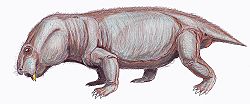| Dicynodontoides Temporal range: Late Permian,
| |
|---|---|

| |
| Restoration of Dicynodontoides recurvidens | |
| Scientific classification | |
| Domain: | Eukaryota |
| Kingdom: | Animalia |
| Phylum: | Chordata |
| Clade: | Synapsida |
| Clade: | Therapsida |
| Suborder: | †Anomodontia |
| Clade: | †Dicynodontia |
| Family: | †Kingoriidae |
| Genus: | †Dicynodontoides Broom 1940 |
| Species | |
| |
| Synonyms | |
| |
Dicynodontoides is a genus of small to medium-bodied, herbivorous, emydopoid dicynodonts from the Late Permian. The name Dicynodontoides references its “dicynodont-like” appearance (dicynodont = two-dog-tooth) due to the caniniform tusks featured by most members of this infraorder. Kingoria, a junior synonym, has been used more widely in the literature than the more obscure Dicynodontoides, which is similar-sounding to another distantly related genus of dicynodont, Dicynodon. Two species are recognized: D. recurvidens from South Africa, and D. nowacki from Tanzania.[1]
Dicynodontoides is primarily known from fossil localities in South Africa and Tanzania, though several specimens unidentified to the species level are known from Zambia, Malawi, and India.[1][2][3] Unlike several other members of the remarkably disparate emydopoid clade, Dicynodontoides did not survive into the Triassic, and its temporal distribution is restricted to the Late Permian.[1]
- ^ a b c Angielczyk K.D., Sidor C.A., Nesbitt S.J., Smith R.M.H & Tsuji L.A. 2009. Taxonomic revision and new observations on the postcranial skeleton, biogeography, and biostratigraphy of the dicynodont genus Dicynodontoides, the senior subjective synonym of Kingoria (Therapsida, Anomodontia), Journal of Vertebrate Paleontology, 29:4, 1174-1187, DOI: 10.1671/039.029.0427
- ^ Ray, S., & Bandyopadhyay, S. 2003. Late Permian vertebrate community of the Pranhita-Godavari Valley, India. Journal of Asian Earth Sciences 21:643–654.
- ^ Jacobs, L. L., Winkler, D.A, Newman, K.D., Gomani, E.M., and Deino, A. 2005. Therapsids from the Permian Chiweta Beds and the age of the Karoo Supergroup in Malawi. Palaeontologia Electronica 8:1–23.